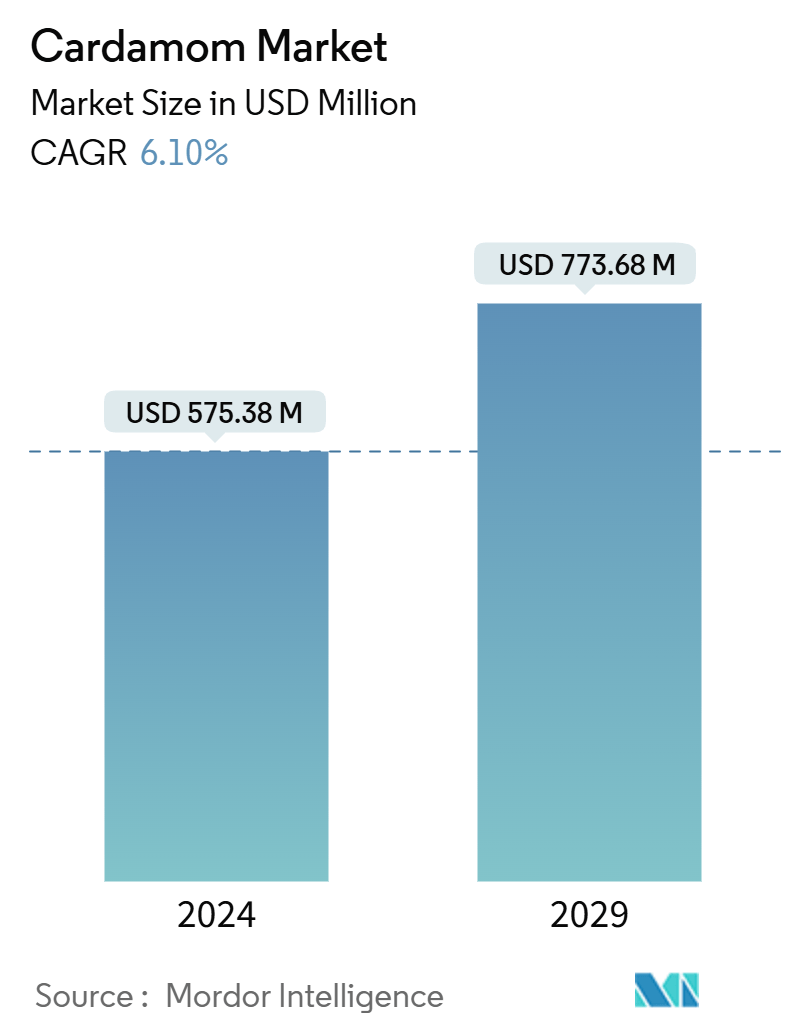Market Size of Cardamom Industry

| Study Period | 2019 - 2029 |
| Market Size (2024) | USD 575.38 Million |
| Market Size (2029) | USD 773.68 Million |
| CAGR (2024 - 2029) | 6.10 % |
| Fastest Growing Market | Asia-Pacific |
| Largest Market | Asia-Pacific |
Cardamom Market Analysis
The Cardamom Market size is estimated at USD 575.38 million in 2024, and is expected to reach USD 773.68 million by 2029, at a CAGR of 6.10% during the forecast period (2024-2029).
- In recent years, consumer purchasing patterns have considerably evolved owing to rising income levels and economic developments. The cardamom market is anticipated to grow exponentially in the coming years due to its variety of uses and various phenomenal attributes. Cardamom has its advantages, from making tea to curing heart-related disorders. The key reason behind the development of cardamom is its essential use in Ayurvedic medicines.
- Globally, the rise in demand for Ayurvedic medicines is increasing the demand for cardamom. It is one of the most expensive spices in the world. It is a warming spice, enriched with Vitamin C, Calcium, Magnesium, and Iron. Essence derived from the cardamom seed is used in the production of medications that treat heartburn, intestinal spasms, irritable bowel syndrome (IBS), intestinal gas, constipation, liver and gallbladder complaints, and loss of appetite. It is also an ingredient in pills that treat sexual dysfunctions and urinal complications. Furthermore, the intake of cardamom helps in flushing out the toxins that could otherwise harm the skin and body.
- Another major factor behind the growth of the cardamom market is its immense use in its taste-enhancing ability and the food and beverage industry. With its sharp flavor, Cardamom is widely used in Indian cooking to enhance the aroma of both savory and sweet dishes. Even though it is mostly known for flavouring Asian dishes and used to flavour confectionery, pastries, and baked products by the rest of the world. In addition, cardamom seeds are also used as an additive to tea and coffee. Thus, the food and beverage industry is expanding rapidly worldwide, leading to the growth of the cardamom market. Also, the growth of the cardamom industry is due to the accelerating use of cardamom in developing regions, including Latin America, the Middle East, Africa, Southeast Asia, etc. These regions consume more amount of cardamom products such as cardamom oil, concoction drink, etc. Cardamom is the third most expensive spice worldwide, which can only be owned by the upper middle-class population. However, the high production and processing costs of cardamom and the availability of other cheap spice flavors are the key factors that restricts the growth of the market.
Cardamom Industry Segmentation
Cardamom is known as the queen of spices. Green cardamom, black cardamom, and Madagascar cardamom are the major types of cardamom cultivated worldwide. The cardamom market is analyzed by Production (Volume), Consumption (Volume and Value), Imports (Volume and Value), Exports (Volume and Value), and Price trend analysis. The market is segmented by Geography into the United States, Guatemala, Indonesia, India, Nepal, Saudi Arabia, and the United Arab Emirates. The report offers the market size and forecasts in terms of value (USD) and volume (metric ton) for the above-mentioned segments.
| Geography | |
| United States | |
| Guatemala | |
| Indonesia | |
| India | |
| Nepal | |
| Saudi Arabia | |
| United Arab Emirates |
Cardamom Market Size Summary
The cardamom market is poised for significant growth, driven by evolving consumer purchasing patterns and increasing income levels. Its diverse applications, from culinary uses to medicinal benefits, particularly in Ayurvedic medicine, are propelling its demand. The spice's role in enhancing flavor in the food and beverage industry further contributes to its market expansion. The growing popularity of cardamom in developing regions such as Latin America, the Middle East, Africa, and Southeast Asia is also a key factor in the market's growth. Despite being one of the most expensive spices globally, its high production costs and competition from cheaper spice alternatives pose challenges to market expansion.
Asia-Pacific leads the cardamom market, with India, Sri Lanka, and Vietnam being major producers. The region's dominance is attributed to increased consumer spending on food and beverages, the rise of online retailing, and a preference for natural ingredients. Initiatives by key players and governments, such as the inclusion of cardamom in festival kits and the launch of e-selling platforms, are expected to further stimulate market growth. The spice's health benefits and its extensive use in Asian cuisines, coupled with supportive government policies, are anticipated to drive the market forward in the coming years.
Cardamom Market Size - Table of Contents
-
1. MARKET DYNAMICS
-
1.1 Market Overview
-
1.2 Market Drivers
-
1.2.1 Increasing Demand in Ayurvedic Medicines
-
1.2.2 Accelerating Use in Food and Beverage Industry
-
1.2.3 Increased Adoption of Cardamom in Pharmaceuticals and Cosmetics Industry
-
-
1.3 Market Restraints
-
1.3.1 High Production and Processing Cost
-
1.3.2 Availability of Other Cheap Spices
-
-
1.4 Value Chain Analysis
-
-
2. MARKET SEGMENTATION (Production Analysis in Volume, Consumption Analysis by Volume and Value, Import Analysis by Value and Volume, Export Analysis by Value and Volume, and Price Trend Analysis)
-
2.1 Geography
-
2.1.1 United States
-
2.1.2 Guatemala
-
2.1.3 Indonesia
-
2.1.4 India
-
2.1.5 Nepal
-
2.1.6 Saudi Arabia
-
2.1.7 United Arab Emirates
-
-
Cardamom Market Size FAQs
How big is the Cardamom Market?
The Cardamom Market size is expected to reach USD 575.38 million in 2024 and grow at a CAGR of 6.10% to reach USD 773.68 million by 2029.
What is the current Cardamom Market size?
In 2024, the Cardamom Market size is expected to reach USD 575.38 million.

